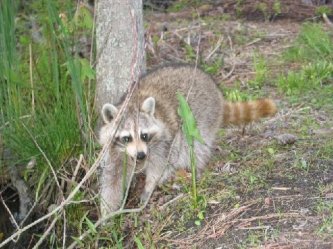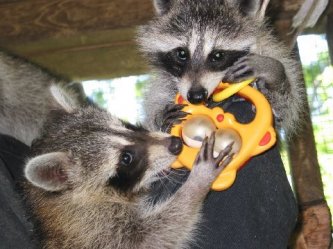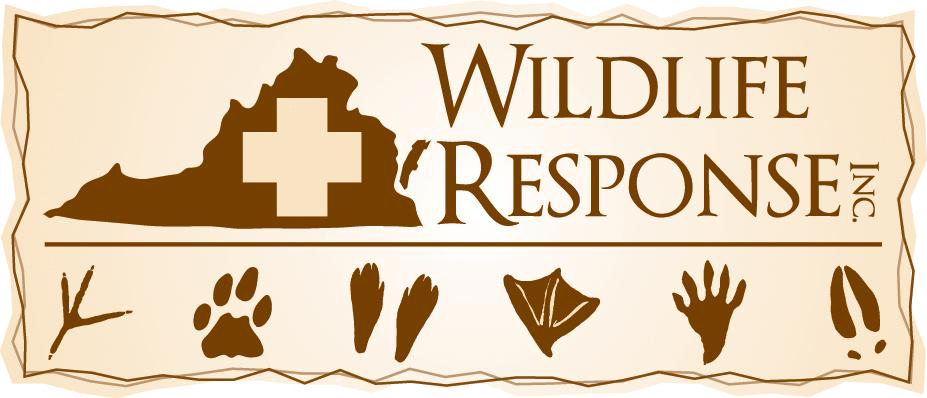(Procyon Lotor)
 Raccoons are found throughout the continental United States. The North American raccoon fossil evidence dates its existence to two million years ago. The name “procyon” is from a Greek word meaning dog and the “lotor” from the latin word meaning “the washer”. The name raccoon is derived from the Algonquin Indian word “arakinem” meaning “he scratches with his hands”. The back mask and ringed tail makes the raccoon distinctive among the other mammals of North America. The northern raccoons tend to have darker fur color than their southern cousins. The raccoons living in salt water marshes tend to have a redder shade to their fur. Adult weights average 12 to 18 pounds but a top weight of 30 pounds is possible.
Raccoons are found throughout the continental United States. The North American raccoon fossil evidence dates its existence to two million years ago. The name “procyon” is from a Greek word meaning dog and the “lotor” from the latin word meaning “the washer”. The name raccoon is derived from the Algonquin Indian word “arakinem” meaning “he scratches with his hands”. The back mask and ringed tail makes the raccoon distinctive among the other mammals of North America. The northern raccoons tend to have darker fur color than their southern cousins. The raccoons living in salt water marshes tend to have a redder shade to their fur. Adult weights average 12 to 18 pounds but a top weight of 30 pounds is possible.
A raccoon’s feet are naked on the soles with five toes. Its sense of touch is acute. The front paws are believed to be four times as sensitive as the back feet. They have well developed dexterity and are able to open many different types of containers. The “washing” behavior of a raccoon more accurately reflects a need to tactually experience things. The cat-like claws make the raccoon an excellent climber.
Both senses of hearing and vision are keen. Their vision is adapted to its nocturnal activities. They are most likely color blind and reflect light as a greenish glow.
Raccoon language ranges from the chirring, trilling and purring of the young to the scream, snarls and growls of the adult.
Raccoons are good swimmers, but avoid deep water unless necessary to escape danger.
Raccoons are very curious. Young raccoons pick up things constantly and put them in their mouths. They actively learn what is edible. Due to their intelligence and adaptability, they are found in a wide variety of habitats in rural and urban areas.
They are at least as intelligent as dogs and cats. They prefer mature woodlands. Urban areas provide both natural foods and abundant cast offs from human tables. Shelter can be found in uncapped chimneys, attics, under porches and yard buildings. Cities provide extensive travel corridors for the clever raccoon willing to use the dry storm drains.
 In the spring, a pregnant female will select a birthing den only days before the babies arrive. Liter size ranges from two to seven. The babies are called cubs. They will remain with their mother until fall. Raccoons are not territorial. They tolerate each other by avoidance. Occasionally cubs will remain with their mother for the winter but most often it is the cubs that will den together for the first winter. The average life span of a raccoon is 7 years.
In the spring, a pregnant female will select a birthing den only days before the babies arrive. Liter size ranges from two to seven. The babies are called cubs. They will remain with their mother until fall. Raccoons are not territorial. They tolerate each other by avoidance. Occasionally cubs will remain with their mother for the winter but most often it is the cubs that will den together for the first winter. The average life span of a raccoon is 7 years.
A raccoons diet varies. They will eat fruits, vegetables, acorns, earthworms, small mammals, such as mice, birds, eggs and amphibians . Those living near water will eat fish and aquatic animals. They are not regarded as effective or efficient hunters. Their fondness for grapes and sweet corn sometimes leads to conflicts with humans. Raccoons will add 30% to their body weight before winter. They do not hibernate, so the fat reserves will benefit their survival. On extremely cold days or bad weather they will remain in a state of topor for several days.
The raccoon is one of four animals, including bat, fox and skunk, that are considered to be a primary carrier of rabies in the United States. Raccoon rabies was documented in Virginia and West Virginia for the first time in 1977, after a group of wild raccoons were brought from Florida to repopulate a hunting area. Exposure to rabies is defined as an animal bite, scratch or contamination of mucous membranes or unintact skin by saliva or nervous tissue. The incubation period can range from 9 days to over one year. This disease can have a variety of signs. The “furious” form of the disease will cause affected animals to attack non-prey species, such as, pets, people and livestock. The “dumb” form will cause an animal to have a staring expression and appear very lethargic. Paralysis and convulsions can occur in either form of the disease. Raccoons can also carry a round worm called “baylisascaris procyonis” that can infect humans if eggs are ingested or inhaled from dry feces.
(reprinted with permission from Wild at Heart)



